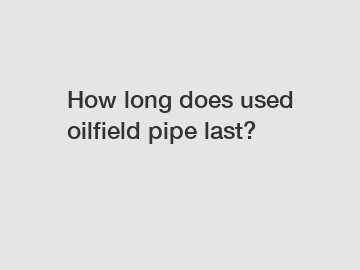How long does used oilfield pipe last?
How long does used oilfield pipe last?
Used oilfield pipe is a critical component in the energy industry, serving various purposes in drilling and production operations. But how long can this pipe be relied upon to perform its intended functions? Let's explore this question and delve into the factors that dictate the lifespan of used oilfield pipe.
1. Quality of the pipe:

The longevity of used oilfield pipe heavily depends on the quality of the material used during its initial manufacturing. Pipes made from high-quality, durable materials such as steel or composite materials tend to last longer than those made from inferior materials. Rigorous quality control measures and adherence to industry standards play a crucial role in ensuring the longevity of the pipe.
2. Maintenance and inspections:
Regular maintenance, coupled with thorough inspections, significantly impacts the lifespan of used oilfield pipe. By conducting routine inspections, any signs of corrosion, wear and tear, or other damage can be promptly identified, allowing for timely repairs or replacements. Implementing a rigorous maintenance program is essential to ensure the pipe's durability and longevity.
3. Operational conditions:
The harsh operating conditions experienced by used oilfield pipe also affect its lifespan. Pipes exposed to extreme temperatures, corrosive chemicals, high pressures, and abrasive fluids are subject to accelerated wear and degradation. The intensity and duration of these operating conditions need to be considered when estimating the lifespan of the pipe.
4. Previous usage and handling:
Knowing the history of the used oilfield pipe is crucial in determining its remaining lifespan. Factors such as previous usage, handling procedures, and the environments the pipe has been exposed to can provide valuable insights into its current condition. If the pipe has been subjected to aggressive drilling operations or mishandling in the past, its life expectancy may be compromised.
5. Proper storage and transportation:
Storage and transportation have a significant impact on the longevity of used oilfield pipe. Adequate protection against weather conditions, moisture, and other potential sources of damage during storage is crucial. Additionally, proper handling and secure packaging during transportation help prevent any unintended stress or impact that could shorten the pipe's lifespan.
6. Corrosion prevention:
Corrosion is a primary concern when it comes to the lifespan of used oilfield pipe. The presence of corrosive fluids, such as hydrogen sulfide or carbon dioxide, can accelerate the corrosion process. Implementing effective corrosion prevention measures, such as coatings, cathodic protection, or inhibitor treatments, can extend the life of the pipe by providing a protective barrier against aggressive substances.
7. Consideration of load and stress factors:
The load and stress factors applied to used oilfield pipe should be within its design specifications. Exceeding the pipe's maximum load capacity or exposing it to excessive stresses can lead to premature failure. Adhering to safe operating limits and guidelines set by industry standards is essential to ensure the longevity of the pipe.
In conclusion, the lifespan of used oilfield pipe depends on several crucial factors. The quality of the initial manufacturing and adherence to industry standards play a significant role. Regular maintenance, inspections, and proper handling procedures contribute to a longer lifespan. Operational conditions, previous usage history, and corrosion prevention measures are additional considerations. By carefully considering these factors and implementing appropriate measures, it is possible to maximize the lifespan of used oilfield pipe and ensure its safe and reliable operation in the energy industry.
Want more information on drill collar function, smooth drill collar, cheap used oilfield pipe for sale? Feel free to contact us.

Comments
0